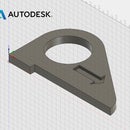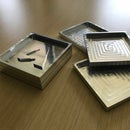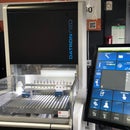Introduction: Self Reflective
Self Reflective, 2016, is a CNC machined piece in aluminum that explores light, material, and optics. It is rich, intense, and confusing to the eye because areas that recede from certain angles flip around and seem to project forward from others. It is reflective of its environment, but holds its own unique relief patterns. Its top surface, which is completely flat, appears to be at multiple depths simultaneously because of microscopic scratches in its surface made by the machining tools. This "holographic" effect--otherwise known as chatoyancy--also appears in natural minerals like opal, moonstone, and tiger eye chrysoberyl.
The paradoxes that make up Self Reflective--flat but deep, reflective but self-contained--are both physical and metaphorical. We self-reflect but the piece also reflects us. These two notions are not always in alignment.
Self Reflective is also a technical exploration. It's the result of the last few years that I have spent exploring CNC machining and Computer Aided Manufacturing at Pier 9. This Instructable will describe how I made the piece and installed it in the 2016 Artist in Residence exhibition at Pier 9.
Step 1: Setting Up Stock
I knew I would be machining this piece in aluminum on the Haas VF2 Mill, and so I started by considering the cutting envelope of the machine. I decided to make four separate panels, each at maximum scale, that would seamlessly connect to comprise a larger pattern. On the Waterjet cutter, I cut the profiles and through-holes for fixturing each panel. By hand, I drilled countersinks for the fixturing hardware.
Step 2: Drawing for Modeling
I've always been interested in incorporating my gestures into digital fabrication. Specifically, I'm interested in a spontaneous scribble being the source of a painstaking digital process. I drew a loose, continuous line in Adobe Illustrator, brought it into Fusion 360, and created a 3D model with extrusions in selected closed sections of the drawing.
Step 3: Adding 3D Features
I didn't want my piece to be comprised solely of flat planes, so I decided to use a simple geometric pattern of raised domes in the background of the drawing. I created one dome in Fusion 360 and used the Pattern feature across all four panels.
I then separated the single model into four separate bodies--one for each panel--to simplify subsequent processes.
Step 4: Computer Aided Manufacturing
Once I had finalized the design, I moved into CAM to control how the machine would make each part. I made four different setups--one for each panel--and placed the Work Coordinate System in the back left corner.
The main toolpath that would create the pattern on the top flat surface was 2D Horizontal. This toolpath tackles the flat sections of the geometry by offsetting from its contours. I applied a pattern to this toolpath to create multiple lines, each rotated by a few degrees, to add a psychedelic look to the piece.
I used a standard parallel toolpath to define the domes, and added texture with a pencil toolpath with multiple stepovers. I constrained the pencil toolpath to the 3d components of the model, because I wanted the top surface to be as flat as possible to aid in the optical effects of the piece.
Step 5: Machining
Each piece took about 4 hours to machine. I made modifications to my tool offsets and toolpath negative stock to leave as I worked, to ensure that I was getting exactly the correct depths in my piece.
Step 6: Hot Off the Machine
The pieces came out well. There were tabs holding them into position inside their frames, so I needed to cut through them and carefully sand the outer contours.
Step 7: Installation
I built a framework out of 8020 to suspend the piece from the underside of the catwalk in the CNC shop at Pier 9.
Step 8: Final Piece
I hadn't really viewed the piece in its final form until after it had been installed, and in fact hadn't seen all four panels together until the last moment, so it was a surprise to me to see how it would turn out.
The piece is unpredictable and ever-changing--radically different from any predictions made from the 3D model that created it.
We have not yet gotten to a point that we can simulate physical reality, and I am truly grateful for this. I believe that art is reliant not just on surprise, but on learning from the corporeal world, being sensitive to physical surroundings, and preserving a sense of awe at the power of the tangible world to transform--and reflect--us.





